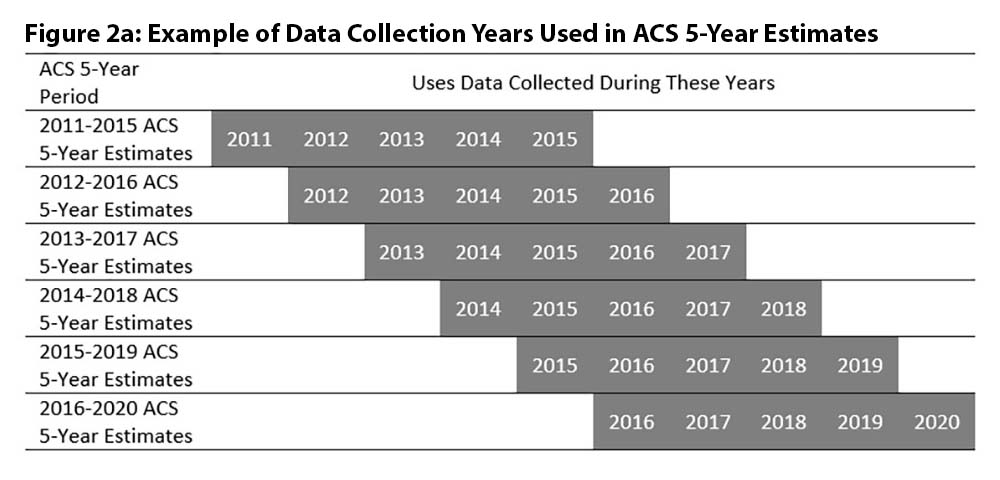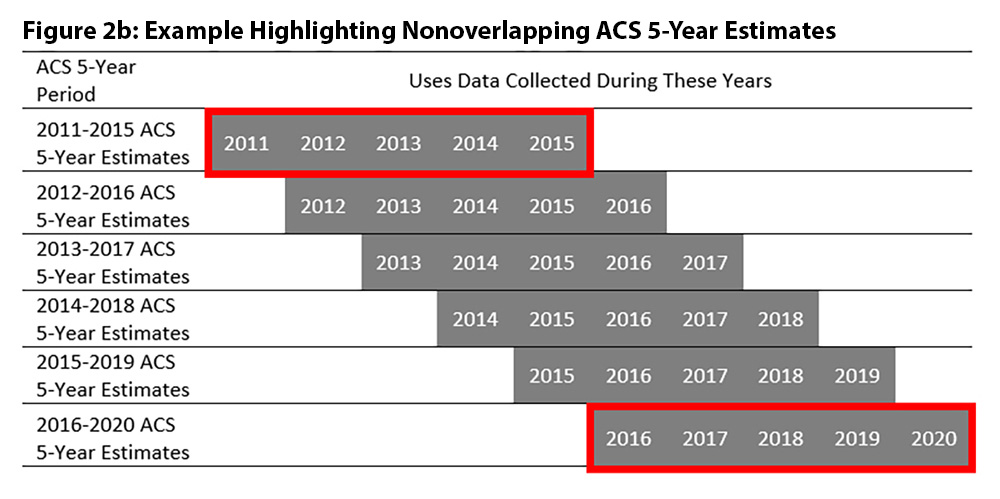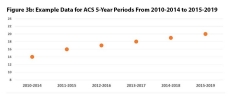Period Estimates in the American Community Survey
Period Estimates in the American Community Survey
Estimated reading time: 8 minutes
The American Community Survey (ACS) helps local officials, community leaders, and businesses understand the social, housing, economic and demographic changes taking place in their communities. Every decision-maker needs information to help them make informed decisions about their communities and businesses. The ACS is the premier source for detailed information about our nation and the data are used to support these data driven decisions.
On March 17, we will release the latest round of ACS estimates — the 2016-2020 5-year estimates, which were delayed due to the COVID-19 pandemic. We know many people will be curious what the ACS estimates can tell us about impacts from the pandemic.
However, it’s first important to recognize that ACS estimates are period estimates and to understand what that means for interpreting them. The ACS has an annual sample size of about 3.5 million addresses with survey information collected nearly every day of the year. Data are combined across time periods to produce estimates. This blog explains period estimates and how to interpret them.
What are period estimates?
Period estimates are produced by combining data collected across a specified period. The ACS is an ongoing survey that collects responses every day of the year. Those responses are combined over a single year to produce 1-year estimates and over 5 years to create 5-year estimates. Figure 1 illustrates the time periods for each.
Unlike the census, which asks people to answer questions in reference to the specific date of April 1 of the census year, the ACS uses the date of the response as a reference date. Since the ACS does not use a single reference date and data are collected throughout the year, the ACS consolidates all the data collected in a calendar year or 5 calendar years to create estimates. The ACS estimates do not represent a fixed date, but rather the characteristics over an entire data collection period. For that reason, we call these “period estimates.”
What periods does the ACS use to produce estimates?
The ACS estimates do not represent a specific point in time during the collection period, but rather a pooling of the data collected during the entire period. For 1-year estimates, the ACS uses data collected in that calendar year — January 1 through December 31. Similarly, the 5-year estimates use data collected over a 5-year period. For example, the 2016-2020 5-year estimates will use ACS data collected from January 1, 2016, through December 31, 2020.
Although people often refer to the 5-year estimates as an “average” of the five 1-year estimates, that is not correct. The U.S. Census Bureau does not take five separate 1-year estimates, add them up, and divide them by five to get a 5-year estimate. Rather, the data for the 5 years are pooled together, weighted and processed as a whole dataset to take advantage of the larger number of records. The 5-year estimate can equate to the midpoint of the time series in certain specific cases but is not always the case.
When conditions in the country are generally stable throughout the period, the ACS estimates are relatively easy to interpret. On the other hand, if conditions drastically changed during the collection period, data users need to take that into consideration when interpreting the estimate. For example, the upcoming 5-year estimates include data collected before the COVID-19 pandemic started, during the pandemic when much of the country was shut down, as well as the latter part of 2020 when the country began opening up. These changing conditions are important to consider when using an estimate that includes 2020 data.
What is a “rolling 5-year period?”
The ACS releases a new 5-year period estimate each year. We call it a “rolling 5-year period” because each year the data for the oldest year in the 5-year period gets dropped, and the data for the newest year are included. Figure 2a illustrates this.
The 2015-2019 5-year estimates and the 2016-2020 5-year estimates both use data collected in 2016, 2017, 2018 and 2019. Thus, the difference between the 2015-2019 and 2016-2020 ACS 5-year estimates is largely driven by the differences between dropping off 2015 and adding 2020.
How should users compare 5-year estimates?
The Census Bureau strongly recommends against comparing estimates in overlapping 5-year periods since much of the data in each estimate are the same.
Instead, the Census Bureau encourages data users to compare 5-year estimates that don’t have any overlapping years of data. Figure 2b shows that the 2011-2015 5-year estimates can be compared to 2016-2020 5-year estimates since those periods do not overlap.
It may be tempting to compare data from overlapping 5-year periods, but such a comparison does not measure what a data user is typically seeking. The difference between the overlapping 5-year estimates in essence is measuring the difference between the nonoverlapping portions. For example, a comparison of the 2015-2019 and 2016-2020 5-year estimates does not measure change between 2019 and 2020, which the user may be interested in knowing. Only when comparing nonoverlapping periods can a user say that the difference between the estimates represents a measure of the change over time between two distinct periods.
In this example, the 5-year estimates increase for each period because in all cases the estimate for the year added is greater than the estimate for the year dropped. For example, the 2011-2015 period uses data from 2011 while the 2012-2016 period uses data from 2016. The estimate for 2016 was higher than the 2011 estimate, which influenced the overall estimates for the two overlapping periods.
This example illustrates that there can be changes in the 1-year data that are not evident in the 5-year data. As a result, it can be misleading to compare overlapping 5-year periods. In this example, comparing the overlapping periods may suggest that there was a consistent upward trend over the decade. However, this comparison fails to show that 2016 actually showed a decrease from 2015 and the slope of the upward increase is greater in the 1-year estimates than the 5-year estimates.
For a better picture of change over time, we recommend only comparing nonoverlapping periods. In this example, data users can compare the 2015-2019 5-year estimate to the 2010-2014 5-year estimate, since the periods do not overlap, and conclude that the estimate has gone up over the two 5-year periods.
Are any of the data adjusted to take into account when they are collected during the period?
Yes, a special adjustment is made for dollar value responses, such as income and utility costs, because of general price-level increases or decreases. Dollar value responses in January are not directly comparable to those collected in December since the value of the dollar changed during this period. Therefore, the Consumer Price Index (specifically the R-CPI-U-RS) is used to adjust the data for inflation.
Annual values like income are adjusted, based on the month the data were collected, to the CPI for January-December of the last year in the period, and monthly values like utility costs are adjusted to the CPI for December of the last year. The only dollar value that is not adjusted for inflation is home value.
Summary and Conclusions
The ACS estimates are based on data collected over a period of time and refer to that period, as opposed to the Decennial Census, which is a snapshot as of April 1. Both the 1-year and 5-year estimates are period estimates. When using the ACS 1-year or 5-year estimates, data users should consider the extent of change in their topic of interest over the period when intrepreting the period estimates.
Since the 5-year data represent a longer timeline, they are not likely to capture abrupt changes. A particular example is the 2016-2020 ACS 5-year data. The vast majority of the data used to create the 2016-2020 5-year estimates include the years before the pandemic; therefore, the ACS is not able to measure the full impact of the pandemic on communities during 2020.
As the examples above show, trends in the 1-year data do not necessarily show up in the trends of overlapping 5-year datasets. When examining the 2016-2020 ACS 5-year estimates to determine their suitability, use caution when comparing those estimates to the 2015-2019 5-year estimates. The difference between the 2015-2019 and 2016-2020 5-year estimates is not just the addition of the 2020 data, but the subtraction of the data collected in 2015. Although it is tempting to compare data from the overlapping 5-year periods to gain insights into the effects of the pandemic, such a comparison does not accurately measure change since much of the same data were used in both 5-year estimates.
Data from the ACS are a powerful tool to help people understand the country down to the smallest levels. Understanding what the period estimates entail is essential for interpreting their results and using the ACS data more effectively. More information is available on the ACS webpage.










